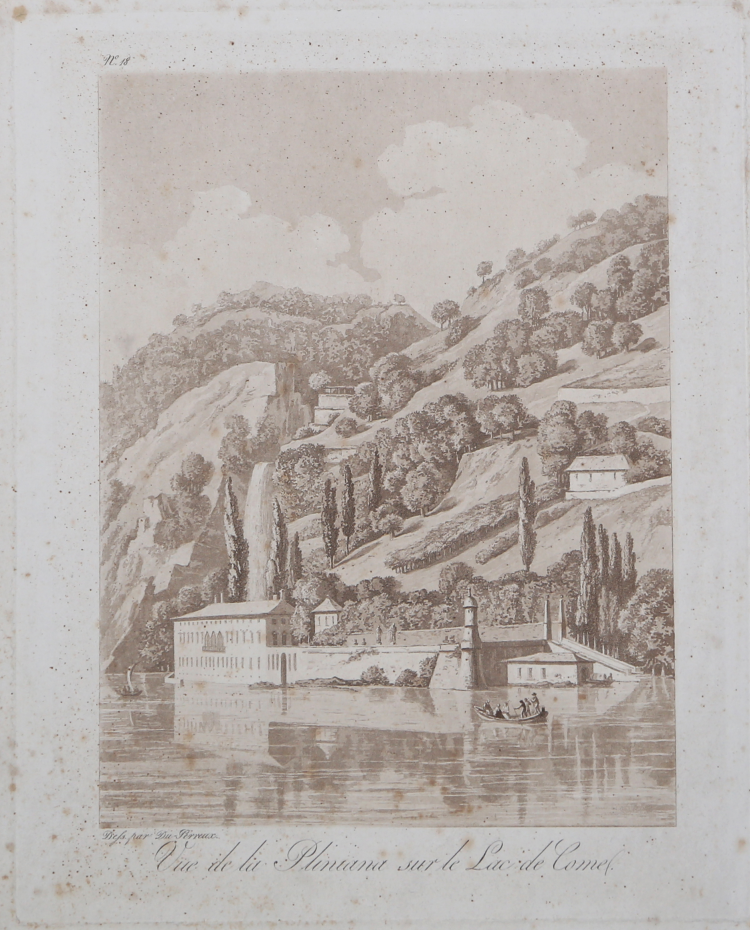



| Reference: | S1395 |
| Author | Philibert Louis Debucourt |
| Year: | 1820 ca. |
| Zone: | Como |
| Printed: | Paris |
| Measures: | 235 x 290 mm |


| Reference: | S1395 |
| Author | Philibert Louis Debucourt |
| Year: | 1820 ca. |
| Zone: | Como |
| Printed: | Paris |
| Measures: | 235 x 290 mm |
Bella veduta tratta dalla celebre opera di Bruun Neegaard "Voyage pittoresque et historique du Nord de l'Italie [...]. Les dessins par Naudet; les gravures par Debucourt…" A Paris: chez l'auteur, rue des petits-augustins n. 26, de l'imprimerie de Firmin Didot Libraire, 1820.
Prima e unica edizione di questa importante opera stampata in sole 200 copie per i sottoscrittori, impreziosita da belle vedute litografiche del nord dell’Italia realizzate da Ghilibert Louis Debucourt sui disegni preparatori di Charles Naudet. Vi si narra il viaggio di Bruun-Neergard e Naudet, cominciato nel luglio del 1806, che si snoda lungo le coste del lago Maggiore, le sue isole, per poi toccare Milano, Como, Pavia, Piacenza e Parma, Bergamo, fino al lago di Garda, Verona e Vicenza. Il progetto editoriale di Neergaard prevedeva – secondo il prospetto – due volumi in-folio grande in papier demi-colombier, caractère neuf saint-augustin ma dei due volumi annunciati solo uno vide la luce a causa della morte dell’Autore, sopraggiunta nel 1824.
Cfr. Astengo 2004; Benezit III, 411; Bibliographie du voyage français 208; Cremonini 91, p. 160-161.
Philibert Louis Debucourt (Parigi 1755 - Belleville 1832)
|
Was a French painter and engraver. Debucourt, was born in Paris in 1755, and became a pupil of Vien. He executed a few plates in mezzotint, such as the Heureuse famille, the Benediction de la mariée, and the Cruche cassée, after his own designs. Most of his work was, however, in aquatint. He became the leading maker of multi-plate colour prints, combining washes of aquatint with line-engraving. He used a number of different techniques, but most involved three colour plates, and a fourth key plate, outlining the design in black. Debucourt's father-in-law was the sculptor Louis-Philippe Mouchy. In the marriage contract Mouchy generously offered to provide a three-room apartment at the Louvre, where Debucourt lived for twelve and a half years. The address of this apartment is often given on his prints. Some of his work was satirical, such as La promenade publique, an aquatint of 1792 showing a crowd in the gardens the Palais-Royal. As well as work from his own designs, he made aquatints after Carle Vernet, including the Horse Frightened by a Lion, the Horse Frightened by Lightning and the Strayed Huntsman. Debucourt was assisted for some years by his pupil and nephew, Jean-Pierre-Marie Jazet. He died at Belleville in 1832.
|
Philibert Louis Debucourt (Parigi 1755 - Belleville 1832)
|
Was a French painter and engraver. Debucourt, was born in Paris in 1755, and became a pupil of Vien. He executed a few plates in mezzotint, such as the Heureuse famille, the Benediction de la mariée, and the Cruche cassée, after his own designs. Most of his work was, however, in aquatint. He became the leading maker of multi-plate colour prints, combining washes of aquatint with line-engraving. He used a number of different techniques, but most involved three colour plates, and a fourth key plate, outlining the design in black. Debucourt's father-in-law was the sculptor Louis-Philippe Mouchy. In the marriage contract Mouchy generously offered to provide a three-room apartment at the Louvre, where Debucourt lived for twelve and a half years. The address of this apartment is often given on his prints. Some of his work was satirical, such as La promenade publique, an aquatint of 1792 showing a crowd in the gardens the Palais-Royal. As well as work from his own designs, he made aquatints after Carle Vernet, including the Horse Frightened by a Lion, the Horse Frightened by Lightning and the Strayed Huntsman. Debucourt was assisted for some years by his pupil and nephew, Jean-Pierre-Marie Jazet. He died at Belleville in 1832.
|